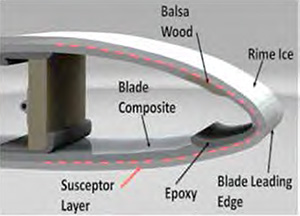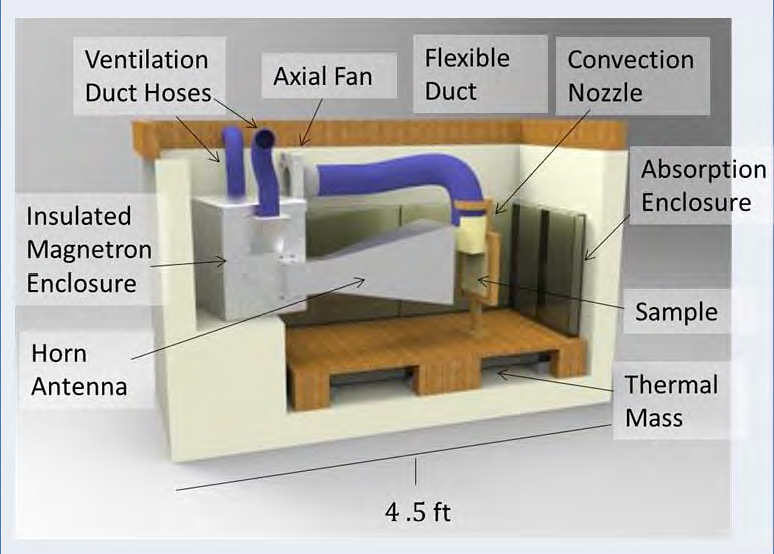Full Project (PDF):
Sponsor:
Benefits
Increased blade life & efficiency, safer operation of cold weather turbines; decrease turbine down‐time
Purpose
Investigate the use of microwave de‐icing technology to enhance the performance of wind turbine blades operating in cold environments
Background and Objectives
Spring 2015 Feasible Study
- Deicing requires: surface heat flux of 1.4kW/m2 ,20‐25 minutes of test period and microwave interactive material
- Options: horn antenna and slotted waveguide antenna at 2.45 or 5.8 GHz
Semester Objectives
- Design and test blade‐compatible microwave susceptor coating layer
- Demonstrate effective microwave delivery at 2.45GHz
- Build a microwave laboratory test facility and collect deicing data
Microwave Absorbing Materials

Problem
- G10/FR4 and Ice are transparent to incident microwave radiation
Solution
- Susceptor coating on blade surface
Requirements
- Maximize conversion of absorbed microwave radiation to heat
- Withstand cyclic thermal stress
- Resistant to UV degradation
Comparison of Coating Methods
| Uniform Surface? | Easy to apply to blade? | Resistant to degradaton? | %Absorption? | Rate of heating | Max temp | |
| Sputtered AI Film | Yes | No | No | Up to 50% | < 3 min | 200 °C |
| Absorptive Paint | Yes | Yes | Yes | Up to 40% | N/A | 900 °C |
| Dielectric Coating | Yes | Yes | Yes | Up to 99% | < 1 min | 800-950 °C |
Microwave System
Microwave generation:
- Operates at 2.45 GHz
- Microwave Power – ~ 1 kW : 60% efficient
- Cheap – around $50
- Easy to drive – circuits already exist
- Air cooled
Microwave delivery options:
| Type | SWA | Horn Antenna |
| Profile | Low (planar form) | High |
| Manufacturing | Good | OK |
| Bandwidth | Narrow | Broad |
| Gain | 15dBi - 20dBi | 15dBi - 30dBi |
| Pattern | Highly directional | Moderately directional |
Practical Application
Tower Configuration
- Arrays of SWAs
- 42 SWAs needed for gain of 9 dBi
- Arrays of horns
- 110 horns needed for gain of 10 dBi
- 40 horns needed for gain of15 dBi
Blade Configuration
- SWA incorporated inside the blade

Microwave Deicing Test Results

Results:
- Ice melted within 30 mins
- Test bed ambient temperature remained below freezing
Team Members:
- Henry Choi (EE)
- Mengqian Gao (MECL)
- Kevin Hritz (MECL)
- Yuyu Hsueh (EE)
- Ryan Jenkins (MECL)
- Kelly Pifer (MECL)
- Yuhan Shi (EE)
- Alex Wholey (MATL)
Focus Area:
Energy and the Environment
Project Type:
Research




